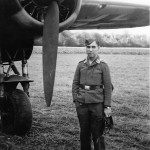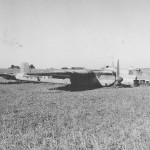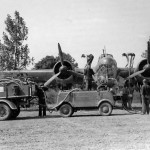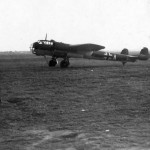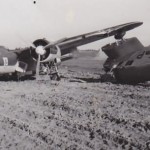German medium bomber Do17 cockpit interior
Dornier Do17 and Luftwaffe soldier
Dornier Do 17 P Stavanger Sola Norway
Dornier Do 17 Z crashed just off the runway, France 1940
Dornier Do17 E of KG77 Mokre Poland 1939
Cockpit of German night fighter Do 17 Z-7 from 2/NJG 2, September 1940
Do17 Z and crew
Do17 Z-2 belly landing
Do17 Z-1 F1+ER Flying pencil of KG76
Dornier Do 17Z of II/KG77 being serviced on Freux auxiliary airfield in Belgium
Dornier Do 17 E in hangar
Do 17 Z-7 Kauz I of the NJG 2 Gilze Rijen Holland 1940
Do 17 P of the 3/KG 2 Insterburg September 1939
Do17 Z of the I/KG76 France
Bomber Do17 Z after crash landing in field
Do17 Z-1 on the snow-covered airfield
Dornier Do17 Z-1 Stavanger Sola Norway
Do 17 Z U5+AL of the 3/KG 2 Bombing Poland September1939
Do17 Z of KG 76 Florian Geyer 1940
Dornier Do 17 P 1940
Dornier Do17 Z rear gunner position
German medium bomber Dornier Do17 Z at a forward airfield in France
Dornier Do17 Z flying pencil
Dornier Do 17Z bombsight and cockpit interior
Bomber Dornier Do17Z 5/KG3
Dornier Do 17 Z “Flying Pencil” after crash landing
Dornier Do17 P on the ground
Do 17 Z coded 3Z+HT of 9/KG 77 in flight, France 1940
Do17 Z-2 of the IV(Erg)/KG3
Dornier Do 17 P code A6+AH of the Aufklarungsgruppe 120 Norway Stavanger
Bomber Dornier Do17 Z-2 “flying pencil”
Dornier Do 17 Z of the I/KG 2
Do17Z with Stammkennzeichen marking NF+LT in flight
Do17 and Ju88 A 7T+BH 1/KGr 606 Ansbach 1941
German Dornier Do 17 bombers over West Ham London 7 September 1940
Dornier Do 17 Z summer 1940
Dornier Do17 Z-2
Warming up the engine of Do17 Z of the 1/KG2
Damaged Do 17 Z 3Z+FT of 9/KG 77 France 1940
Do17 Z of 2/NJG 2 Gilze Rijen September 1940
Opel tanker truck refueling Do17 Z-2
German bomber Do17 Z airfield
Dornier Do17 Z of 5/KG 3
German bomber Do17 Z
Bombers Do 17 P of the KG 51 on the ground, France May 1940
Dornier Do17Z nose
Night fighter Dornier Do 17 Z of the NJG 2 at Gilze Rijen Holland 1940
Dornier Do17 Z wreckage in junkyard, 1940
Dornier Do17 P refueling
Do17 Z 3U+FU of ZG26 at Castel Benito Tripolitania Libya 1943
Do17Z code 3Z+AM of 4/KG77
Dornier Do17 7A+CM of Aufklarungsgruppe 121 wearing a pre-war splinter camouflage scheme
Dornier Do17 P 54+H12 2 KG 255 Stolp Reitz May 1939
Dornier Do17Z coded U5+HA from KG2, 1940
Do17Z 3Z+AM KG77
Dornier Do17 Z of 1/KG 2 with unit marking Athen Tatoi 1941
Dornier Do17 photo
Dornier Do 17M or P
Luftwaffe Dornier Do17P
Crashed Dornier Do17, engine cowling
Dornier Do 17, engines and canopy are covered with a tarpaulin
Dornier Do17 Z of the 1/KG2 with unit marking Athen Tatoi 1941
Dornier Do17 E
Crashed Dornier Do 17E or F, with BMW VI 12-cylinder V-engines
Dornier Do17 engines maintenance
Dornier Do17P cockpit I/KG 255 Stolp Reitz June 1939
Dornier Do17 Z 1/KG2 with unit marking Athen Tatoi 1941
Dornier Do17P I/KG 255 F.13 D-OVEP Stolp Reitz June 1939
Reconnaissance aircraft Dornier Do17P
Dornier Do17E
Dornier Do17 P Rovaniemi Finland Tankwagen Lanz Traktor
Dornier Do17, close-up view of cockpit
Dornier Do17 P Rovaniemi Finland
Dornier Do17 damaged after a crash landing
Dornier Do17
Dornier Do17 P photo
The Dornier Do17 (“Flying Pencil”) made its first flight in November 1934 and was intended as a fast mail-carrier for Deutsche Lufthansa. Rejected by that airline after three machines (all with single fins) had been completed, it was taken up as a high speed bomber by the Reichsluftfahrtministerium (RLM, Ministry of Aviation) the following year and made a spectacular public debut, now with a twin tail assembly, at Zurich in the 1937 International Military Aircraft Competitions. By this time, bomber squadrons of the Luftwaffe were already being equipped with the first two production models, the Do 17E and Do 17F, and in 1938 both of these versions were seeing service in the Spanish Civil War. Also in 1938 the next major series, the Bramo 323 powered Do 17M-l, entered production, closely followed by the reconnaissance Do I7 P with BMW 132N engines. After small numbers of the Do 17 S (reconnaissance version) and Do 17 U (pathfinder) had been built with DB 600A inline engines, a return to the radial Bramo 323 engineswas made in 1939 with the Do 17Z.
On the outbreak of war the Luftwaffe had in service the Do 17 M and Do 17 Z bombers, and the Do I7 P and a handful of Do 17Fs
Production: 2139 aircrafts.
Bibliography
- Boris Ciglic, Dragon Savic: Dornier Do 17. The Yugoslav Story. Operational Record 1937-1947
- Kalevi Keskinen, Kari Stenman: Dornier Do 17 Z, Junkers Ju 88 A-4 – Suomen Ilmavoimien Historia 2
- Richard Smith: The Dornier Do 17 & 215 – Aircraft Profile Number 164
- Karl-Heinz Regnat: Vom Original zum Modell Dornier Do 17
- Christopher F. Shores: Luftwaffe Bomber Camouflage & Markings 1940 – Heinkel He111 – Junkers Ju88 – Dornier Do17 – Osprey Aircam Aviation Series №S10
- David Donald: Warplanes of the Luftwaffe, Barnes and Noble 1994
- Manfred Griehl: Dornier Do-17 E-Z, Do 215 B – The Flying Pencil in Luftwaffe Service
- Heinz J Nowarra: The Flying Pencil, Schiffer Military History
- Manfred Griehl: Dornier Bombers and Reconnaissance Aircraft 1925-1945, Warbirds Fotofax, Arms & Armour Press 1990
- Marek J. Murawski: Dornier Do 17/Do 215, Kagero Monographs 60
- David Wadman, John Bradley: Aufklarer – Luftwaffe Reconnaissance Aircraft & Units 1935-1945, Hikoki Publications, 1997
- R. Smith, Antony L. Kay: German Aircraft of the Second World War, Putnam 1990
- Richard Smith: The Dornier Do 17 & 215, Aircraft Profile 164

